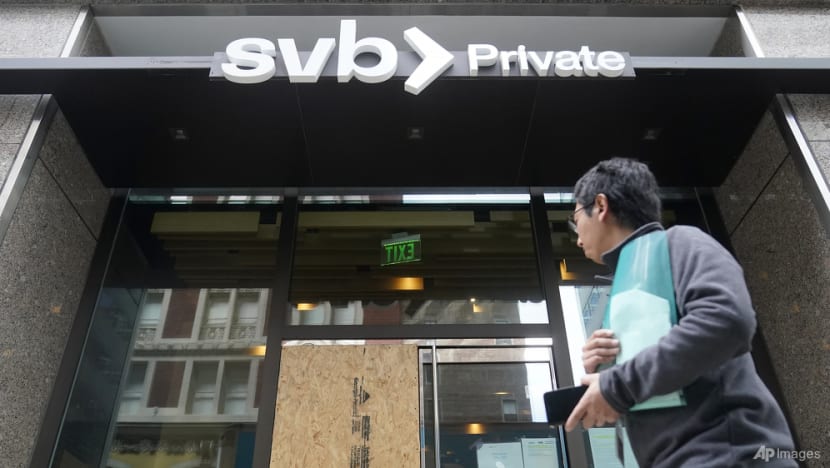The rise and fall of Silicon Valley Bank: Timeline of tech lender's collapse
When Silicon Valley Bank sought to raise funds to shore up its balance sheet, it triggered a bank run instead. Within 48 hours, SVB had collapsed.

SINGAPORE: Before the sudden collapse of Silicon Valley Bank (SVB), the lender in the tech start-up space had about US$209 billion in total assets.
But when it sought to raise funds on Mar 8 to shore up its balance sheet, panicked venture capitalists rushed to pull cash, causing a bank run.
Within 48 hours, SVB had collapsed.
Here’s a look at how events unfolded, leading to the biggest US bank failure since 2008.
SVB: GO-TO BANK FOR START-UPS
Founded in 1983 in Santa Clara, California, SVB quickly became the go-to bank for the growing tech sector there as it focused on the unique financial needs of start-ups.
As the technology industry grew and expanded beyond Silicon Valley, the bank followed suit, establishing offices in other major tech hubs such as Boston, New York and Austin, as well as internationally in countries such as the United Kingdom, China and Israel.
According to SVB's website, it did business with nearly half of all US venture capital-backed start-ups and 44 per cent of US venture-backed tech and healthcare companies that went public last year.
While it was relatively unknown to the general public, SVB was one of the top 20 American commercial banks with US$209 billion in total assets and about US$175.4 billion in deposits, according to the Federal Deposit Insurance Corporation (FDIC).
Related:
THE COVID-19 PANDEMIC
In the early days of the COVID-19 pandemic, the US Federal Reserve kept interest rates near zero in order to boost growth during an economic contraction. The tech sector benefitted significantly from this policy, resulting in inflated valuations that some experts warned were overstated.
SVB grew very quickly between 2020 and 2022, but its disproportionate exposure to tech start-ups was a potential risk area.
FED'S INTEREST RATE HIKE
When the Fed started raising interest rates aggressively last year to tame inflation, higher borrowing costs slowed the momentum of tech companies that had been the source of SVB's growth.
As venture capital dried up due to rising interest rates and fears of a recession, SVB’s clients tapped their deposits to get the money they needed to keep going.
Higher interest rates also eroded the value of long-date fixed interest bonds that SVB bought, making it vulnerable to the shift in monetary policy by the Fed.
SVB CEO SOLD COMPANY STOCKS
Less than two weeks before SVB revealed the extent of its losses, CEO Greg Becker sold US$3.6 million worth of company stock.
It was the first time in more than a year that he had sold shares of parent company SVB Financial Group, according to regulatory filings.
Ratings firm Moody's later warned the company of a potential downgrade.
According to sources who spoke to Reuters, Becker called Goldman Sachs bankers for advice and flew to New York for meetings with Moody's and other ratings firms, worried that the downgrade could undermine investor confidence in SVB's financial health.
PLAN TO SHORE UP FINANCES
On Mar 8, SVB Financial Group announced it had sold US$21 billion of securities from its portfolio at a loss of US$1.8 billion, and that it would sell US$2.25 billion in new shares to shore up its finances.
This backfired.
Venture capitalists, unnerved by the plan, advised their portfolio businesses to withdraw their money from the bank. The capital-raising plan led to SVB's stock collapsing 60 per cent.
On Mar 9, SVB Financial Group scrambled to reassure its venture capital clients their money was safe.
COLLAPSE OF SVB
By the morning of Mar 10, trading in SVB shares was halted.
US authorities swooped in and seized the assets of SVB, after it became clear that a run on deposits made it no longer tenable for the bank to stay afloat on its own.
The bank was put into receivership by the FDIC. This typically means a bank’s deposits will be assumed by another healthy bank, or the FDIC will pay depositors up to the insured limit.
It is the largest bank failure since Washington Mutual in 2008, and also the second-largest failure for a retail bank in the US.
EMERGENCY MEETING OF US REGULATORS
In response to the sudden collapse, Treasury Secretary Janet Yellen convened an emergency meeting of top US banking regulators on Mar 10.
She and the White House expressed confidence in their abilities to respond to the bank failure, and unveiled a series of measures aimed at restoring confidence in the banking sector and settling turbulent markets.
After bank customers were left stranded, financial agencies said in a joint statement on Mar 12 that SVB depositors would have access to "all of their money".
Yellen said the move will protect “all depositors”, signalling aid to those whose accounts exceed the typical US$250,000 threshold for FDIC insurance.
"We are taking decisive actions to protect the US economy by strengthening public confidence in our banking system," the agencies said.
SIGNATURE BANK SHUT
Just two days after Silicon Valley Bank was shuttered, state regulators closed New York-based Signature Bank - a commercial bank with private client offices in Connecticut, California, Nevada and North Carolina.
As of September, almost a quarter of Signature’s deposits came from the cryptocurrency sector, but the bank had announced in December that it would shrink its crypto-related deposits by US$8 billion.
News of the two bank closures sent shockwaves across global trading floors.
BIDEN REASSURES MARKETS
US President Joe Biden moved to reassure markets and depositors on Mar 13, after emergency measures to shore up banks by giving them access to additional funding failed to dispel worries about potential contagion to other lenders.
"Americans can have confidence that the banking system is safe," Biden said in a brief White House address. "Your deposits will be there when you need them."
He also praised the "immediate" action taken by officials.
While the US has moved to protect customers' deposits, Biden made clear that the government won't be bailing out the bank's investors.

















